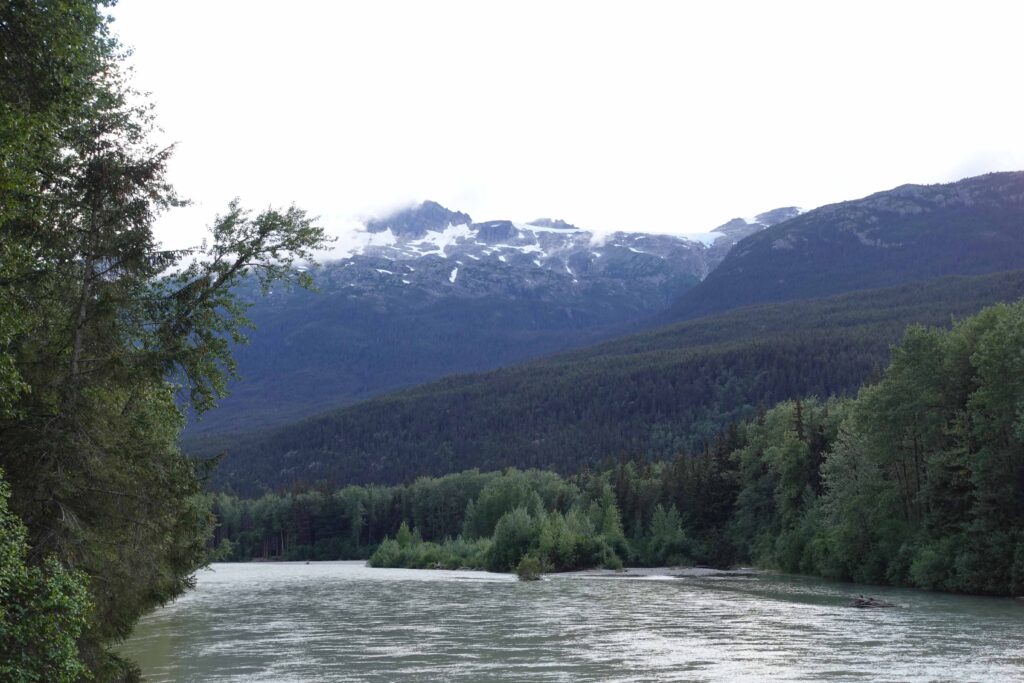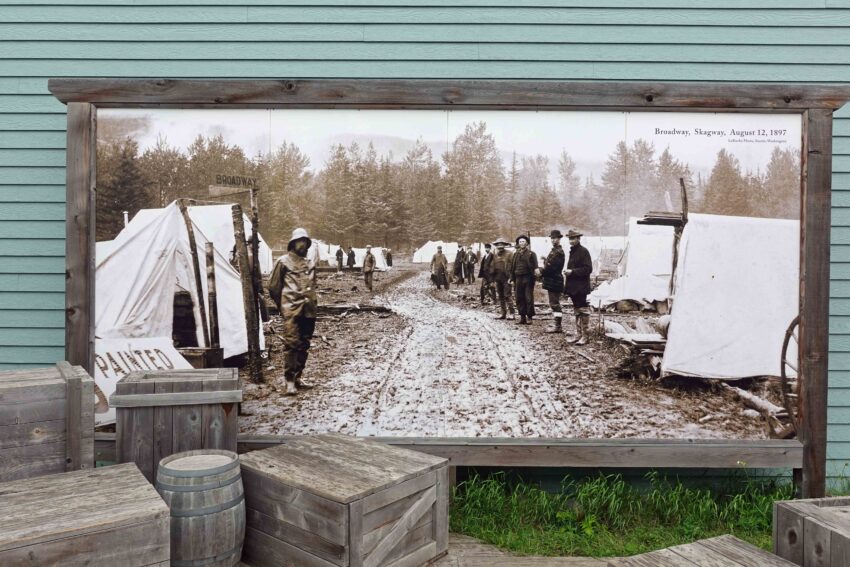Saturday, August 12, 2023: How does the Klondike gold get into the rush?
Info:
With not quite 2,000 people, Haines is a small town north of Juneau, Alaska’s capital. It can be reached from Canada by road, otherwise by ship or plane.
Skagway, along with Dyea, played a major role in the Klondike Gold Rush as the starting point of the two routes to Dawson City. While nothing remains of Dyea, where the Chilkoot Trail started, Skagway enjoys great popularity with its historic downtown. With cruise ships, up to 13,000 people sometimes visit the former Gold Rush town during the day, which was the starting point of the White Pass Trail. Today the Klondike Highway leads from here to the Yukon Territory to the Alaska Highway.
My opinion:
Both places are delightful. Most people who have been to Alaska cite either Valdez or Skagway as the most beautiful place. That’s exactly how it is.
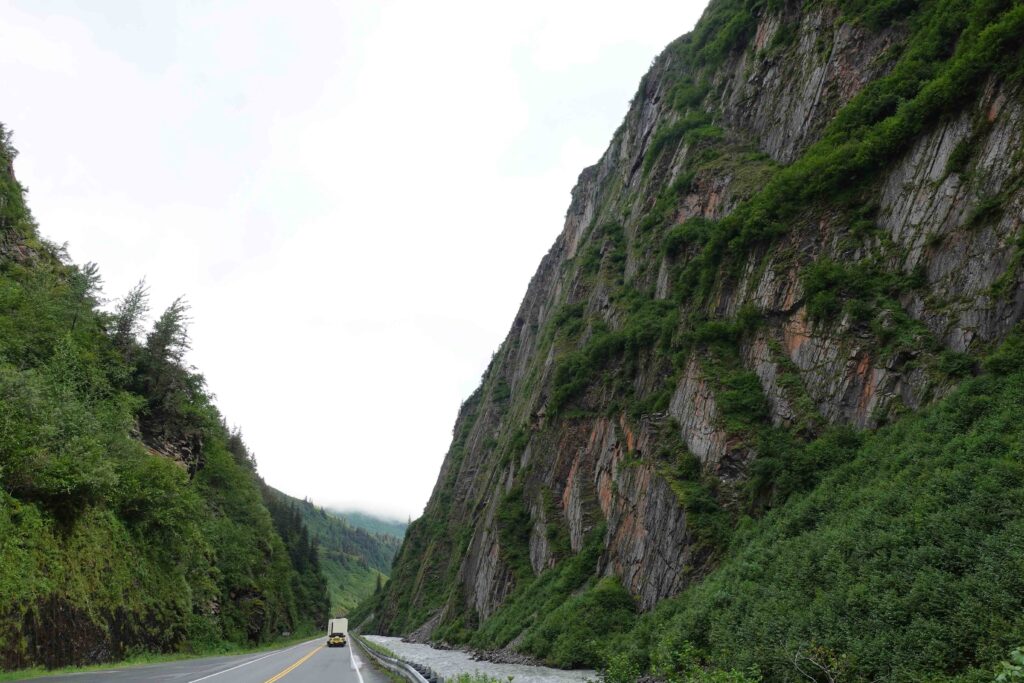
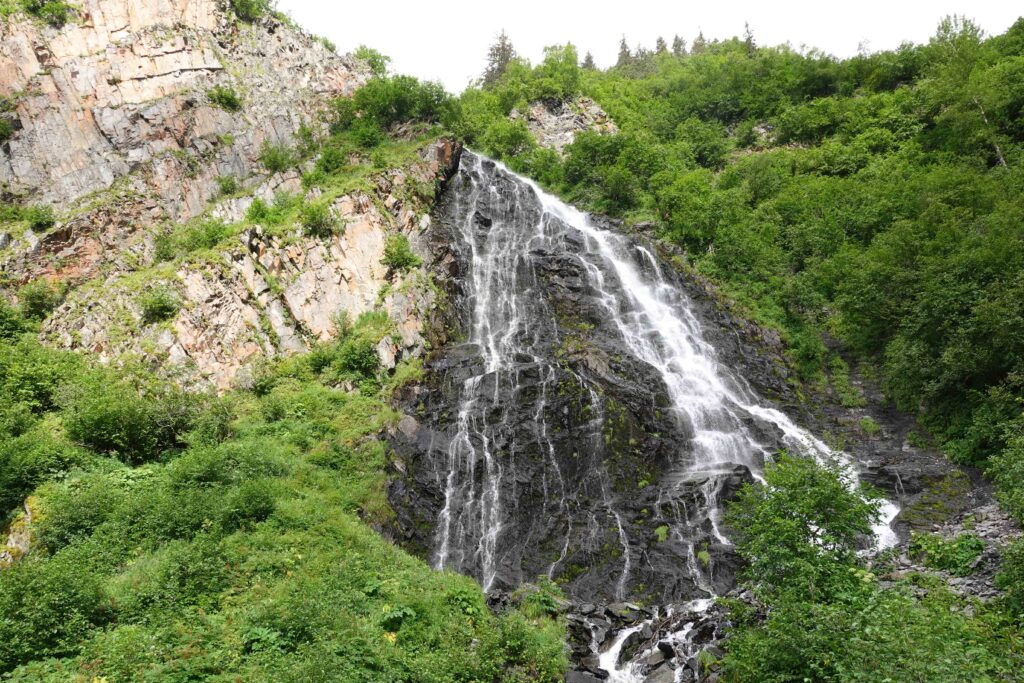
Diary:
From Valdez, the only road leading away is the Richardsen Highway, and that is to Tok. The Trans-Alaska Pipeline runs parallel to it, but underground.
Spectacular are already the first miles through the Chugach Mountains with Keystone Canyon and its waterfalls,Tho mpson Pass with more than 800 m (after all you are driving away from sea level) and Worthington Glacier.
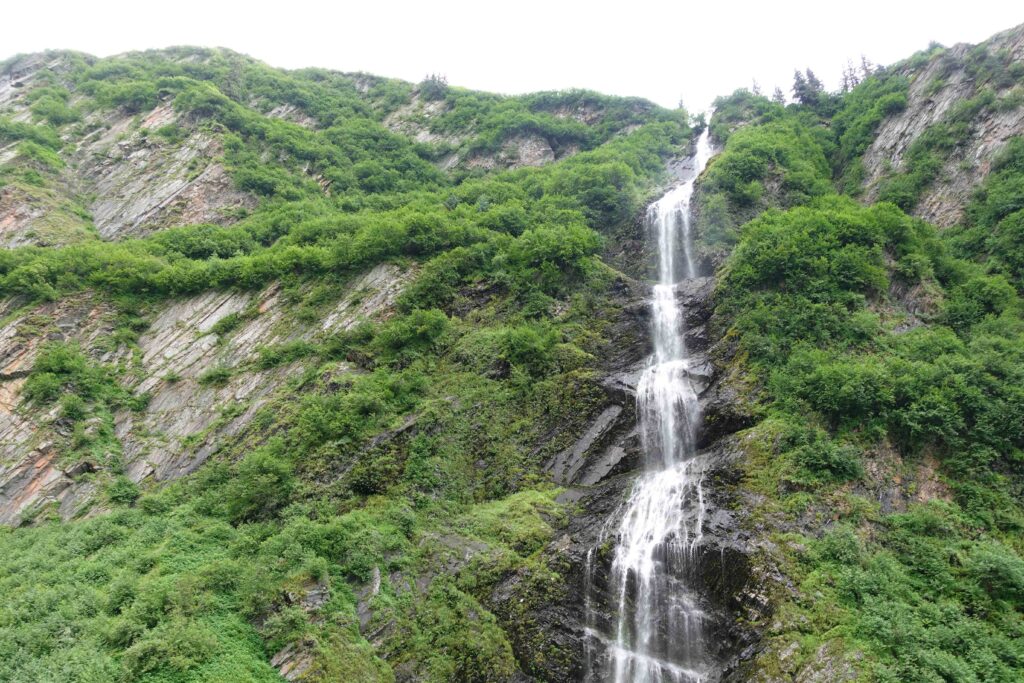

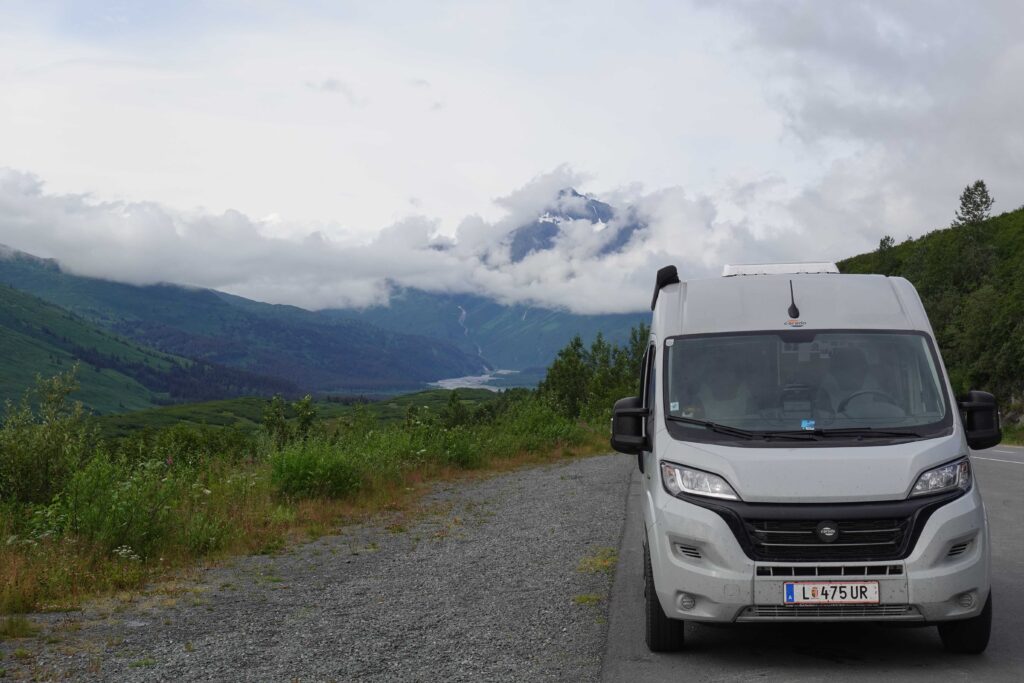

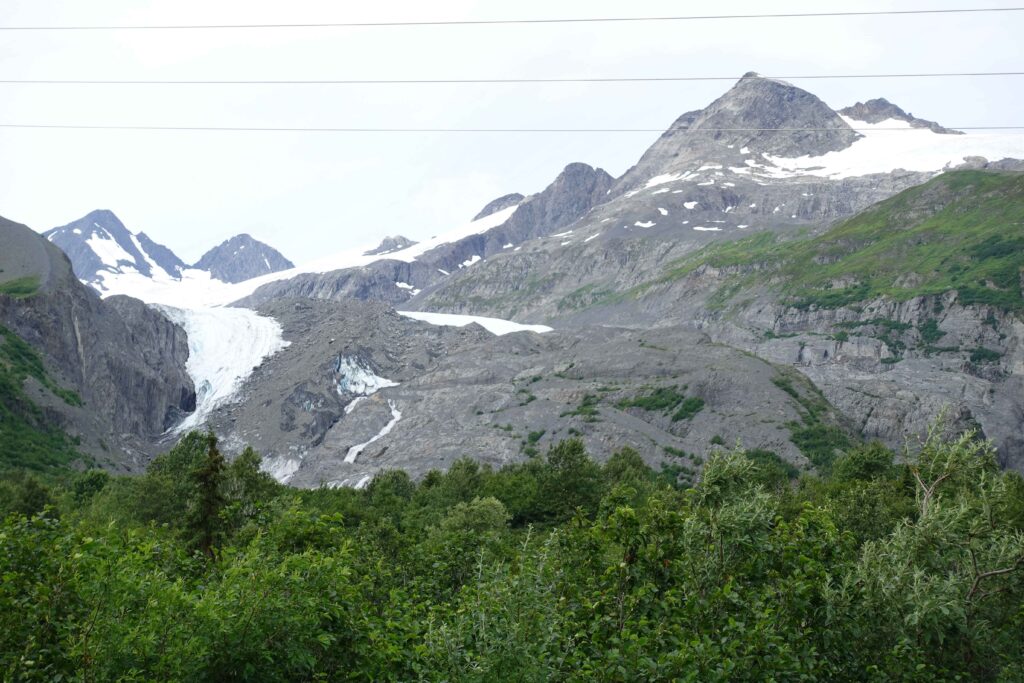
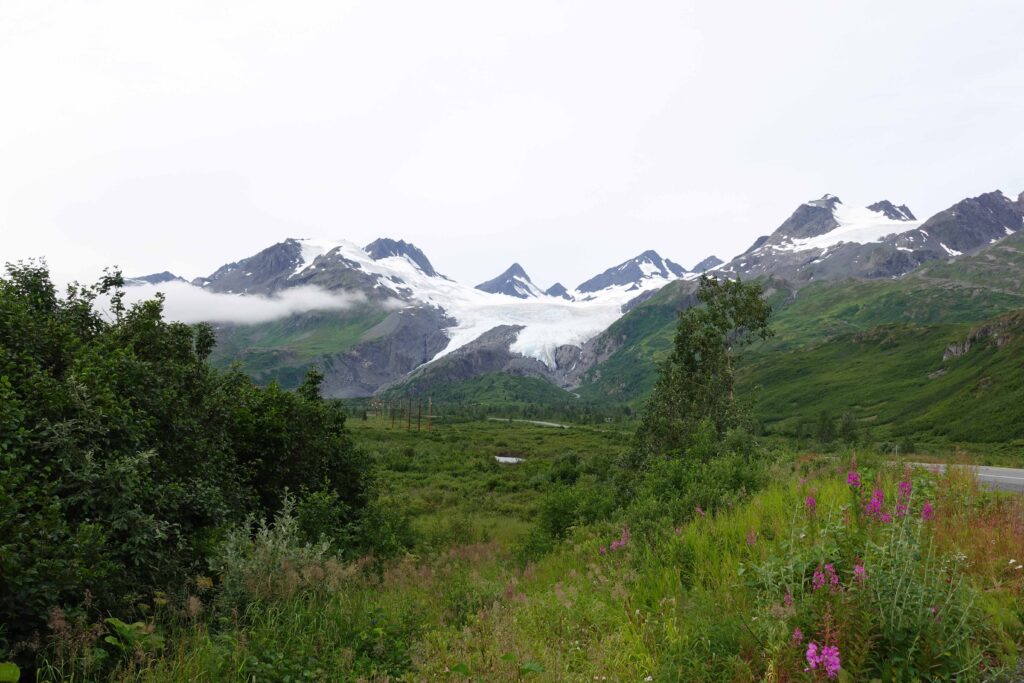
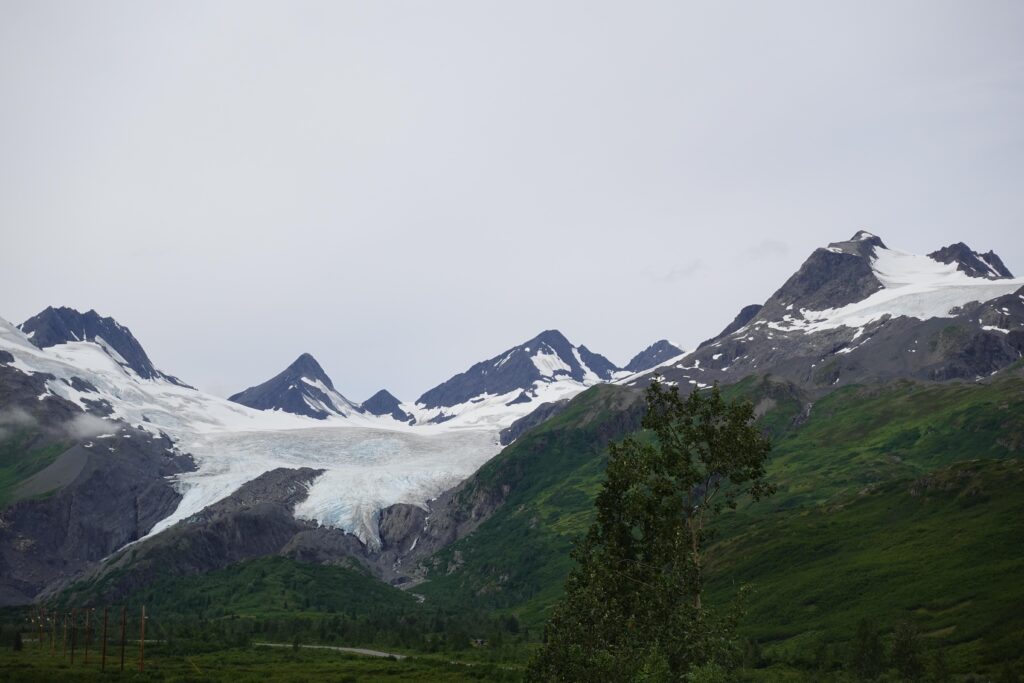
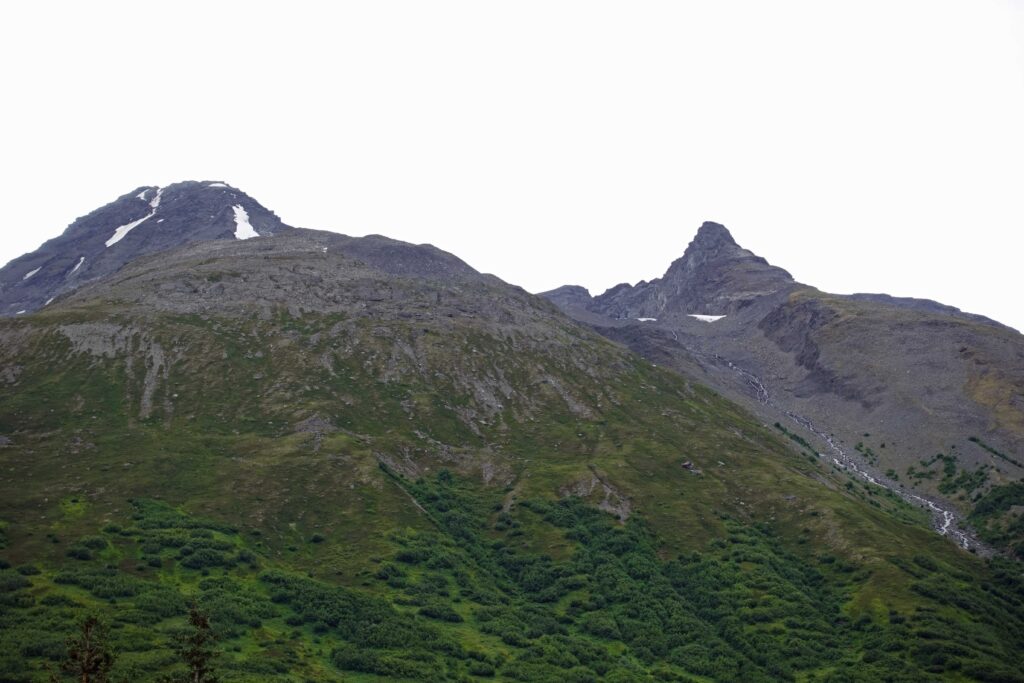
From a distance, the highest elevations of Wrangell St. Elias National Park can be seen, Mount Blackburn at 4,966 m and Mount Wrangell at 4,317 m, an active volcano. In general, the shapes of many mountains do not deny their volcanic origin, together with the final touch they have received from the ice ages.
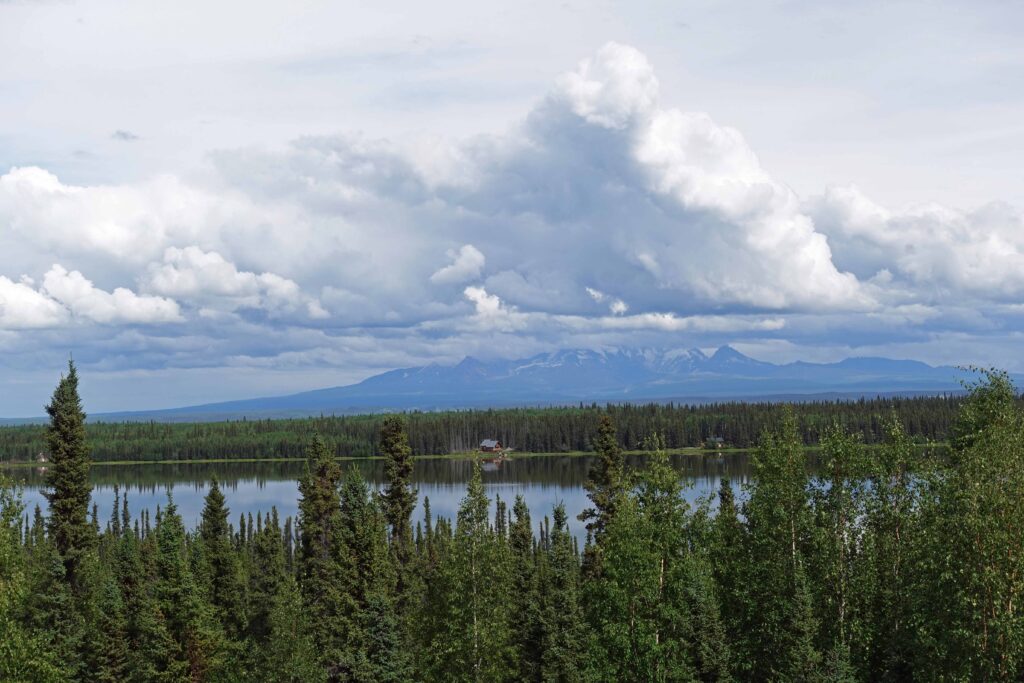

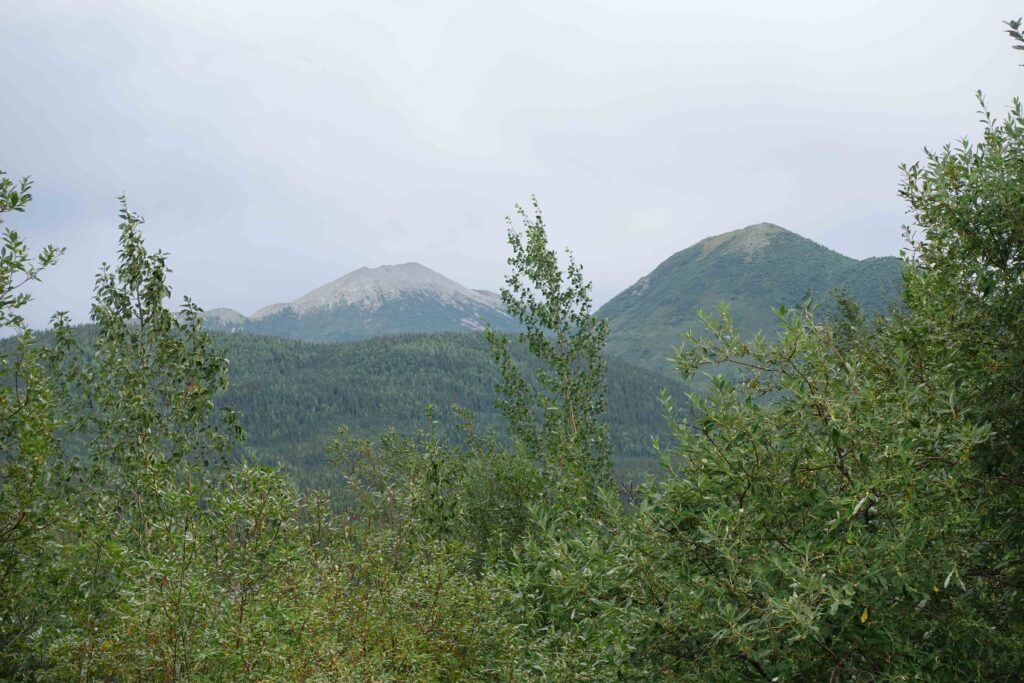
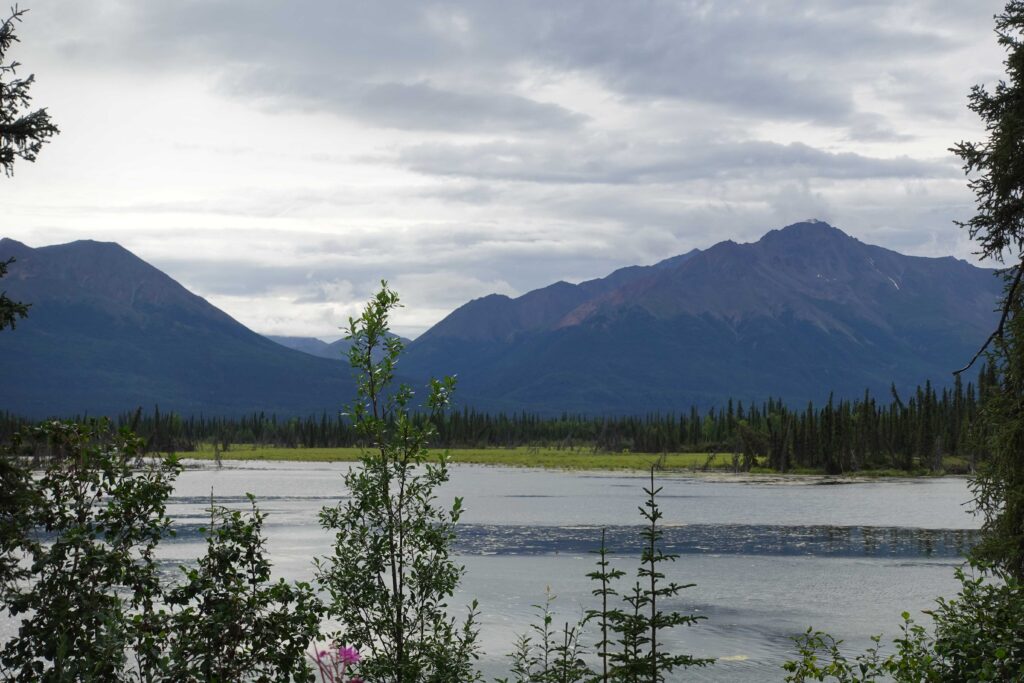
We stayed overnight in Tok and started the next day on the Alaska Highway towards Whitehorse (turning south before). We had skipped this part of the Alaska Highway on our outward trip because we drove the Top of the World Highway instead.
The Alaska Highway between Tok and Haines Junction is terrible. Paved, but similar to the paved section of the Top of the World Highway, not a fun drive. You have to pay attention all the time. Even Annie Way, who, like me, loves unpaved, steep mountain roads with as many U-turns, potholes and bumps as possible, grumbled slightly sourly.
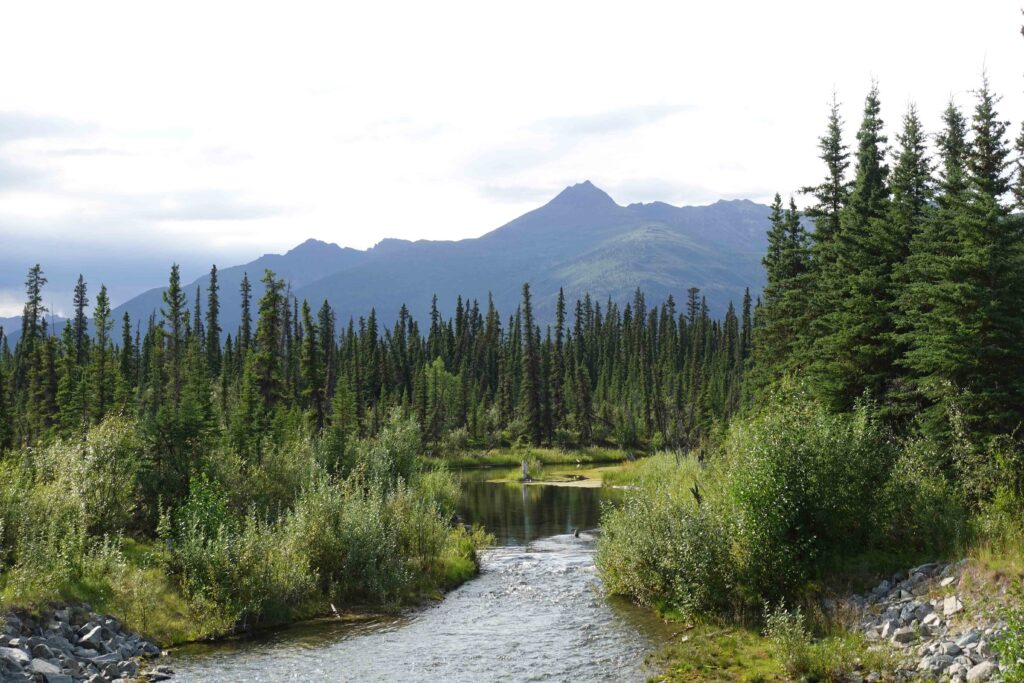
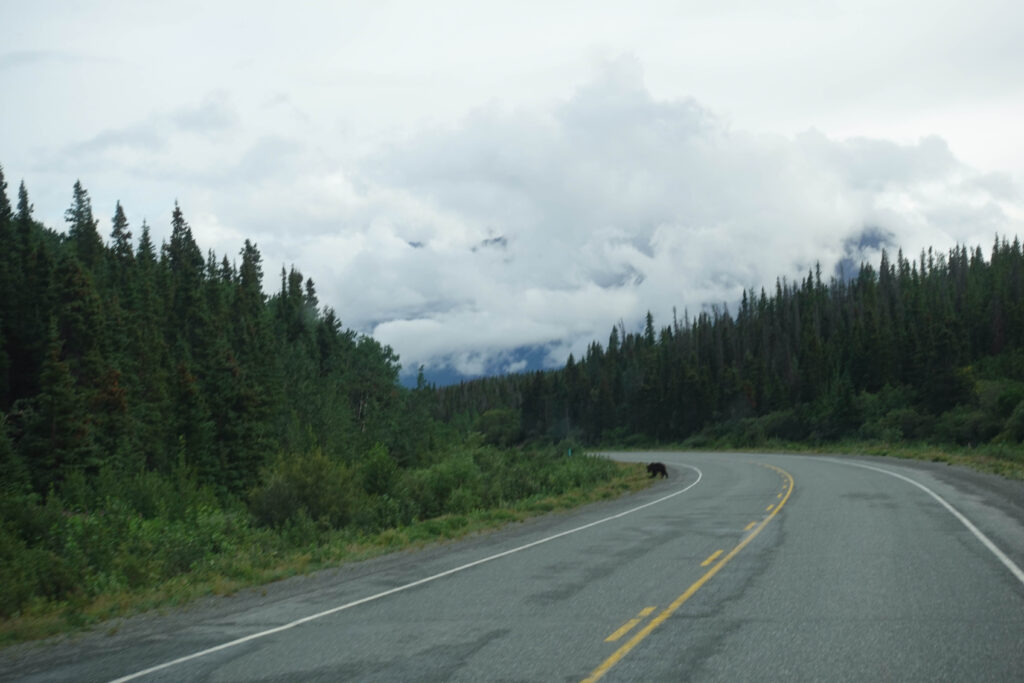
At Beaver Creek there is the border between Alaska and the Yukon Territory. Nice to be back in Canada, even if only for a short time. Cheap gas and cheap accommodation.
I spent the night in Haines Junction and took the Haines Highway from there to – I wonder where it will lead? – That’s right, to Haines, the only place in southern Alaska named after a woman. Mrs. Haines donated to the local mission school, but never went there herself. And Haines Junction is where you turn to get to Haines. Makes sense, doesn’t it?

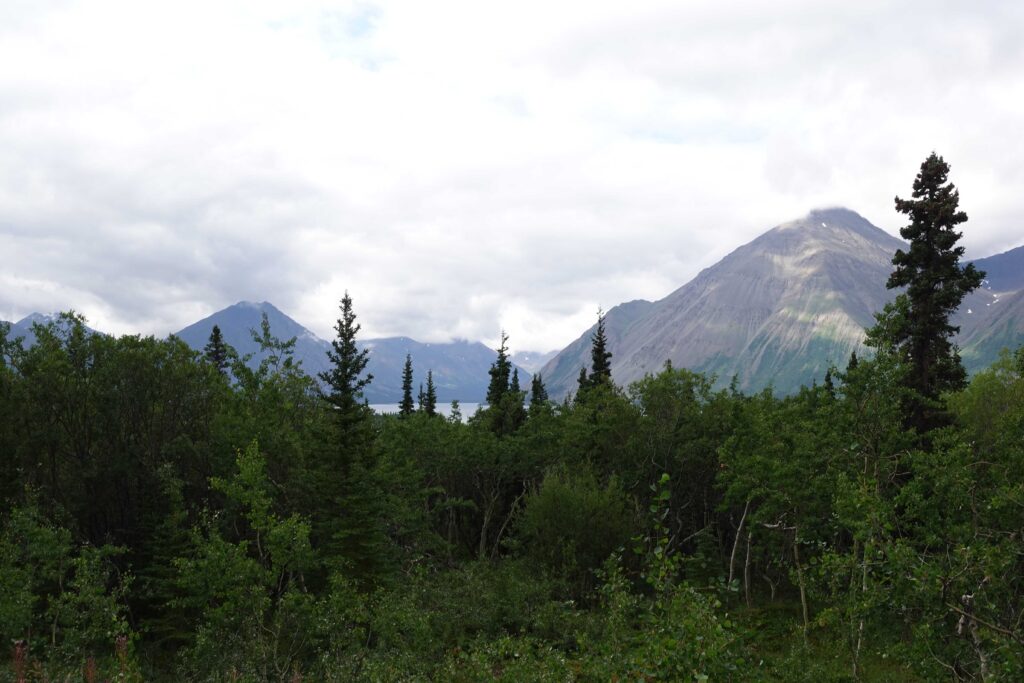
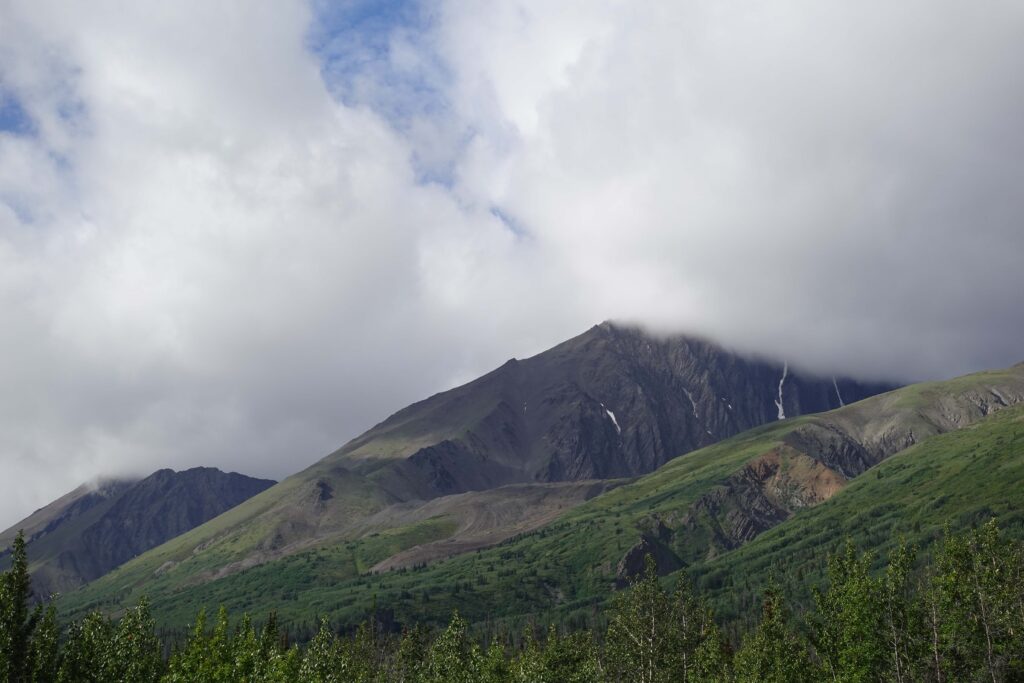


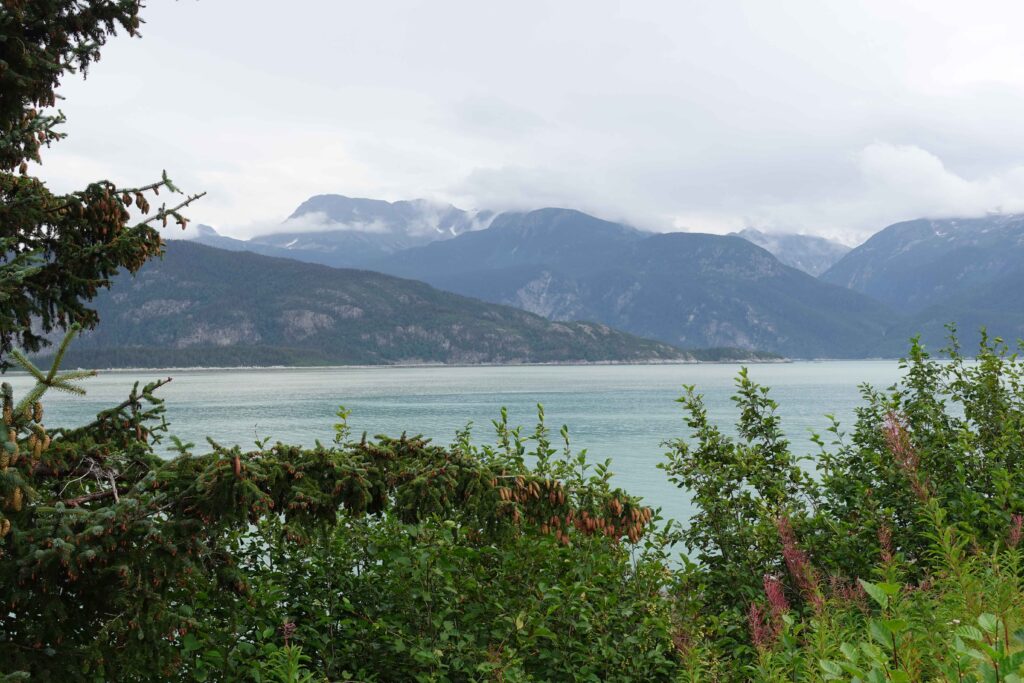
You drive a bit through the Yukon, then through British Columbia, and after that you have to queue up again at the border to get to Alaska. Guns, drugs, lemons? No, only bananas. Bananas seem to be okay. Have a save trip! Enjoy your stay!
I liked Haines from the start, even when a cruise ship threatened to swallow it up. After all, it was only one.
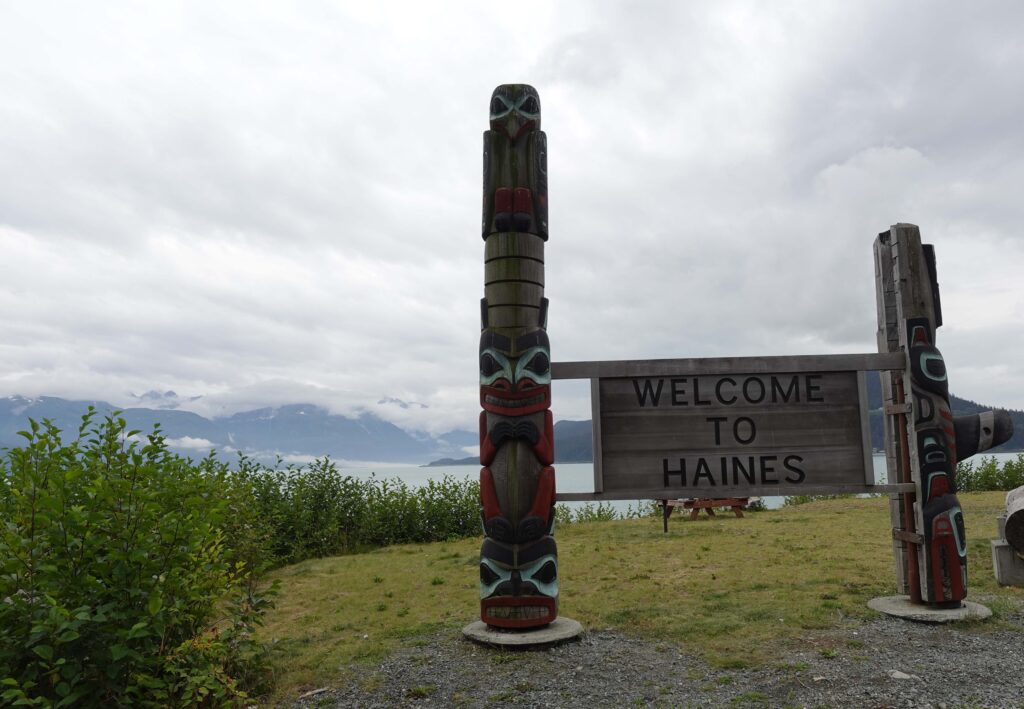
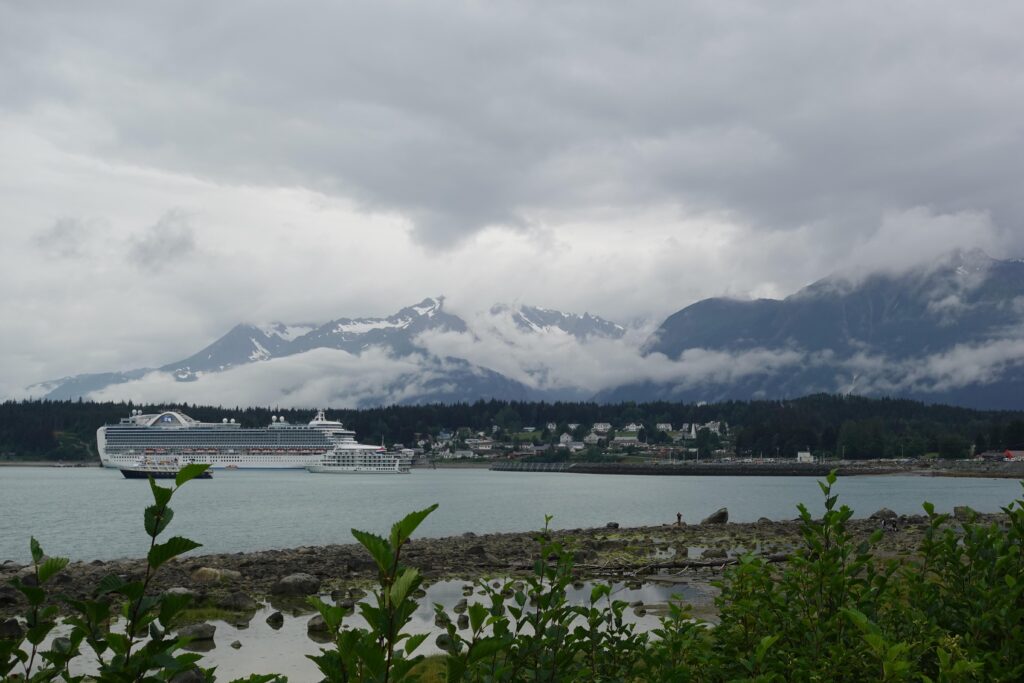
Where the Chilkoot River enters the fjord, salmon migrate upstream at this time of year. According to the Internet, the best opportunity in Alaska to see bears catching salmon.
So I went there immediately because I had seen sea lions in Valdez but no bears. Nothing. Is there a bear curse on me? Bears cross the street behind me, but they disappear as soon as I come up to watch them?
All the other people wondered, because usually there are always bears there. A gentleman from Texas told me he had already personally met twenty of the resident female bears, with their cubs. Twelve in all in the area, ranchers say.
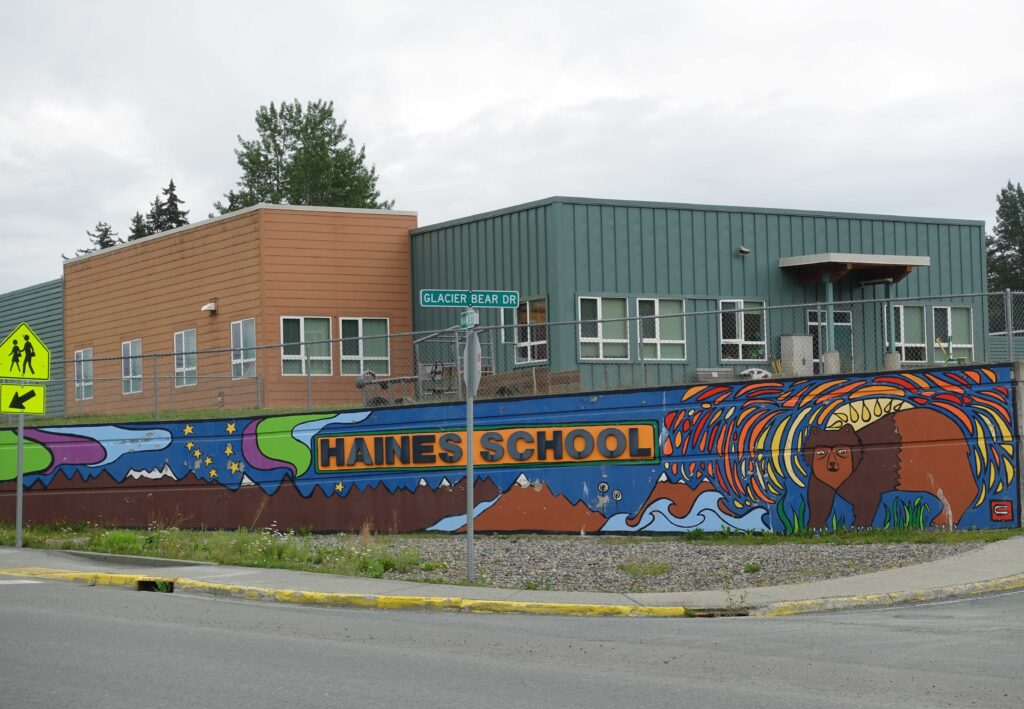
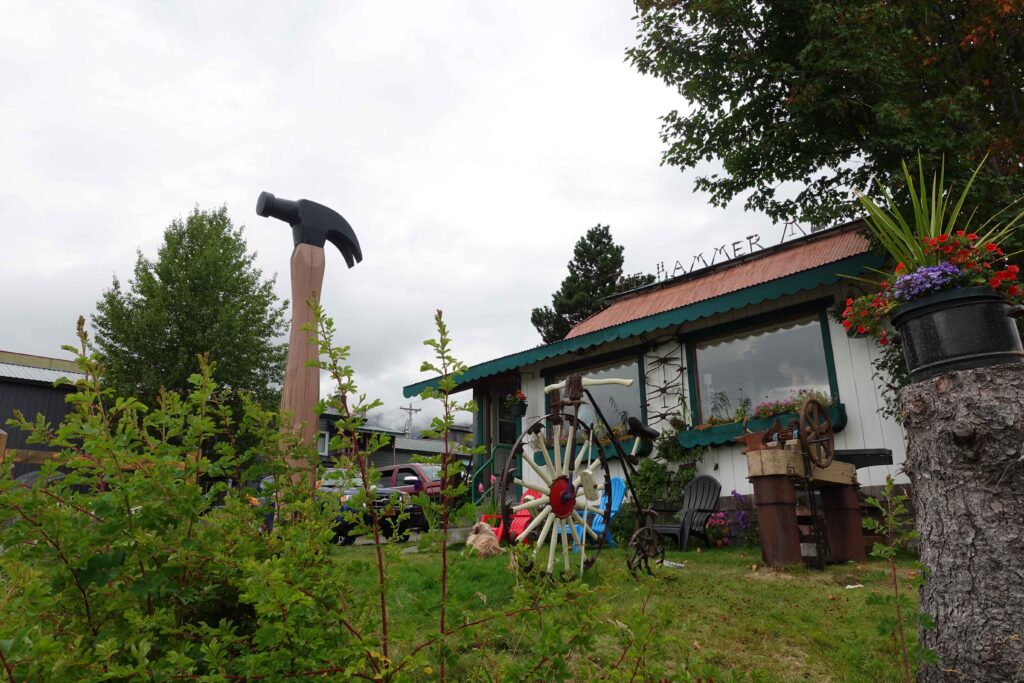
All right, let’s go to Haines. A very original hammer museum is there on the main street, but I only looked at it from the outside. I found the Sheldon Museum and Cultural Center, where one is informed about the life of the Tlingit and about the Gold Rush, quite worth seeing.
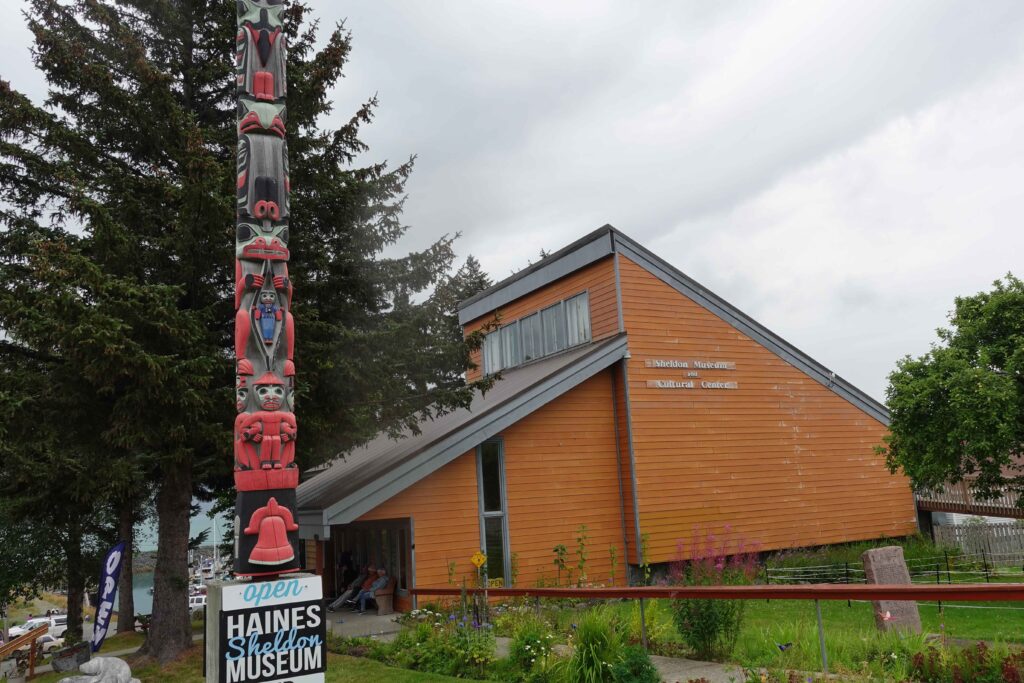
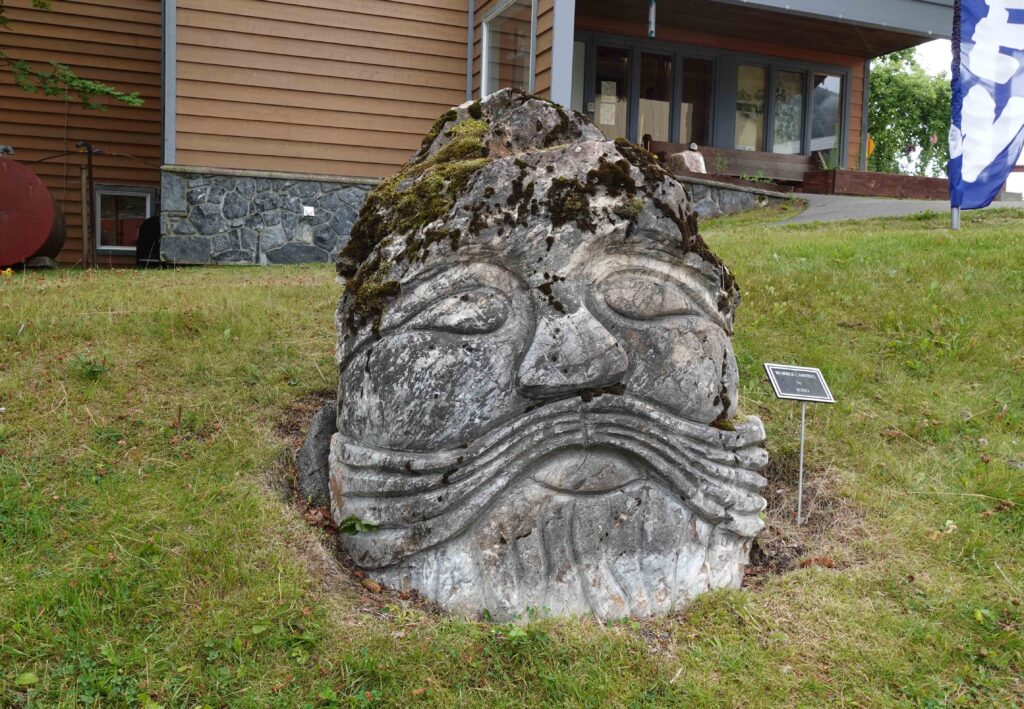
The Chilkat and Chilkoot Tlingit organized themselves in their realm of fjords and salmon rivers, not allowing white settlement. In 1850, Jilkaat Aani, as this alliance was called, provided a thousand warriors and supported an influential shaman who opposed immigration to traditional Tlingit lands. Since they were considered dangerous, the whites left them alone. However, the experience with Russian traders changed the attitude of the Tlingit, so they began to trade with whites from different countries. But no one was allowed to settle in their realm.
In the Tlingit creation story, Raven stole the sun to bring light to the earth. In some versions of the story, life began at the mouth of the Chilkat River, near where the town of Haines now stands.
The Tlingit of Jilkaat Aani were a rich people who found everything they needed in nature to live an abundant life, while respecting that nature.
In 1867 the USA bought Alaska. Beginning in 1897, the area was overrun in the Gold Rush – with no regard for the people who had made their home there for thousands of years.
By the way, I went to the Chilkoot River again, hoping to see bears. They seem to have sensed this and hid.
The next morning, before taking Annie Way on the ferry to Skagway, I tried a third time. People there told of the many bears they had observed the day before. Strange that no one was there now.
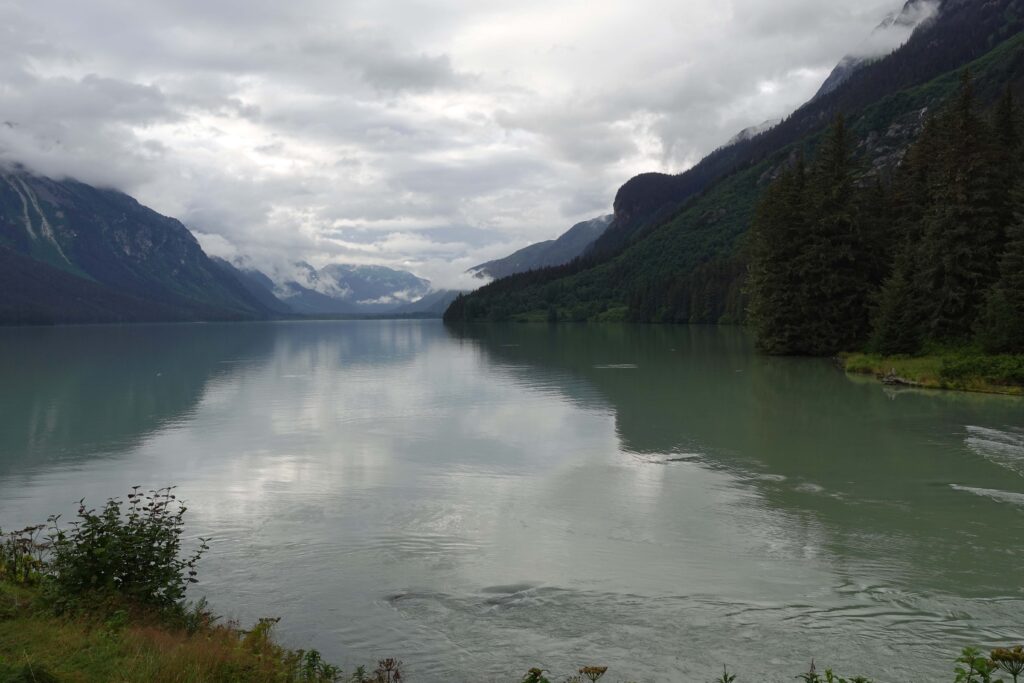
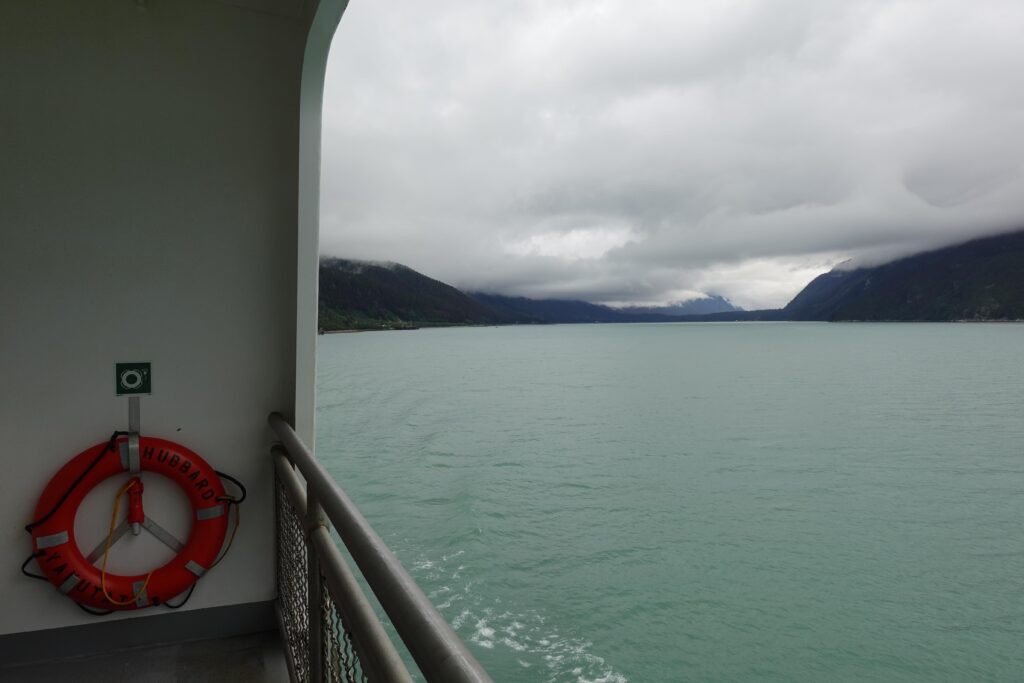
We took the ferry to Skagway, it was even more complicated this time than the trip from Whittier to Valdez, and I decided to avoid ferries in the future. At least in Alaska.
But the ride through the fjord compensated for much. Not for the non-existent bears, but at least for Annie Way’s being squeezed in.
The first thing to see from Skagway were the huge cruise ships. Four of them.
Annie Way got a nice site at one of the campgrounds for a whopping ten Canadian dollars a day, which is 6.9 euros. Great showers, a fantastic dump station, and within a ten minutes’ walk to the historic downtown area, which was overrun with thousands of people. Nevertheless, it was an experience! And in the evening they disappeared on their ships, and the locals showed up.


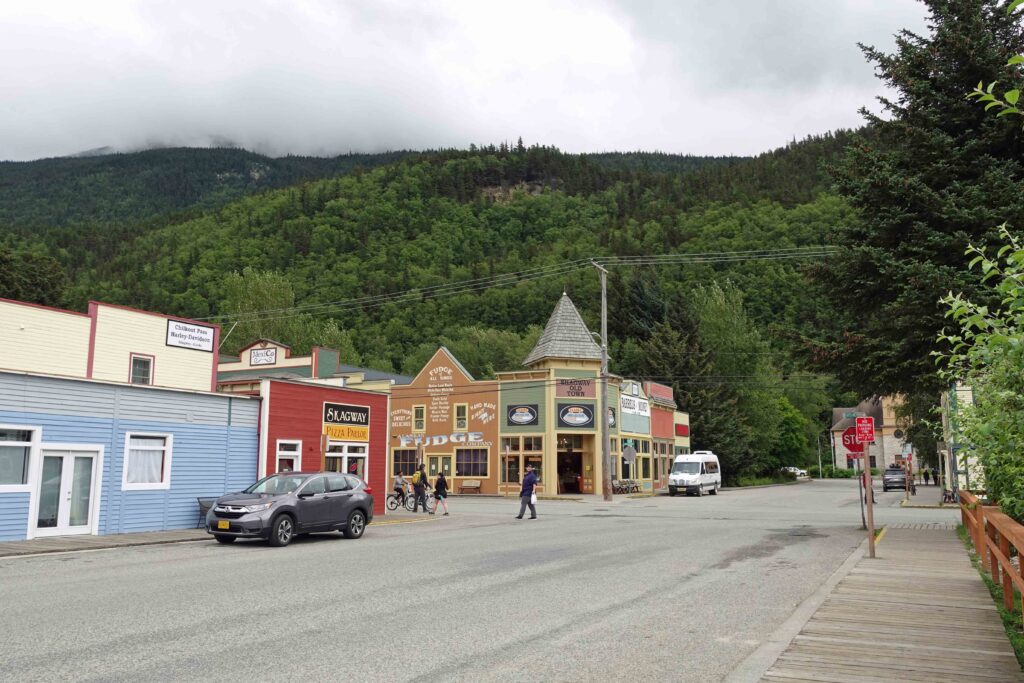
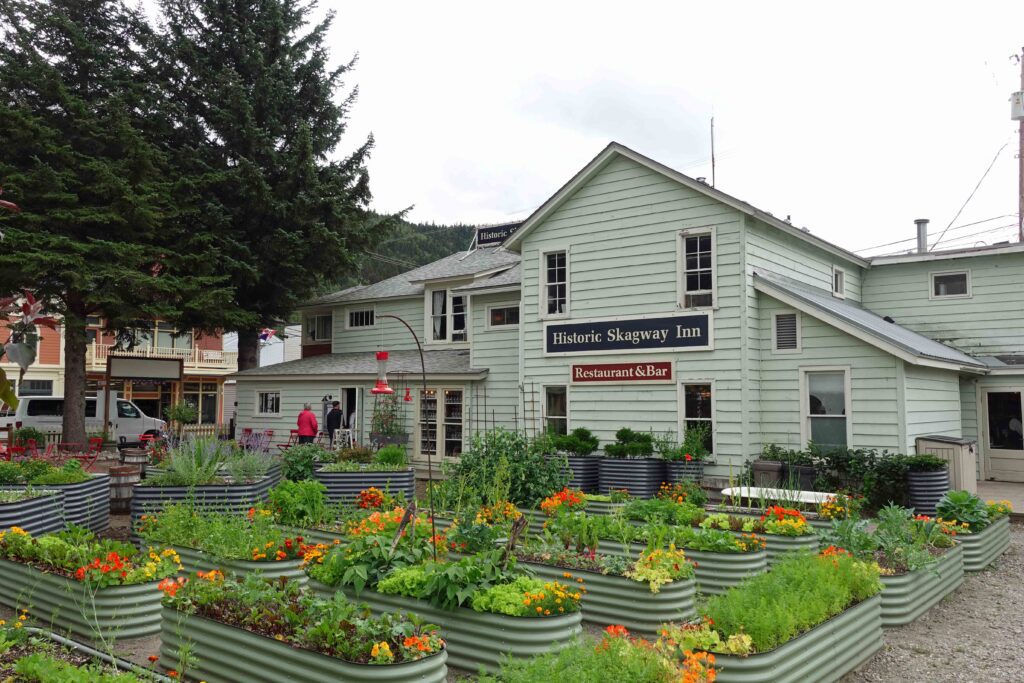
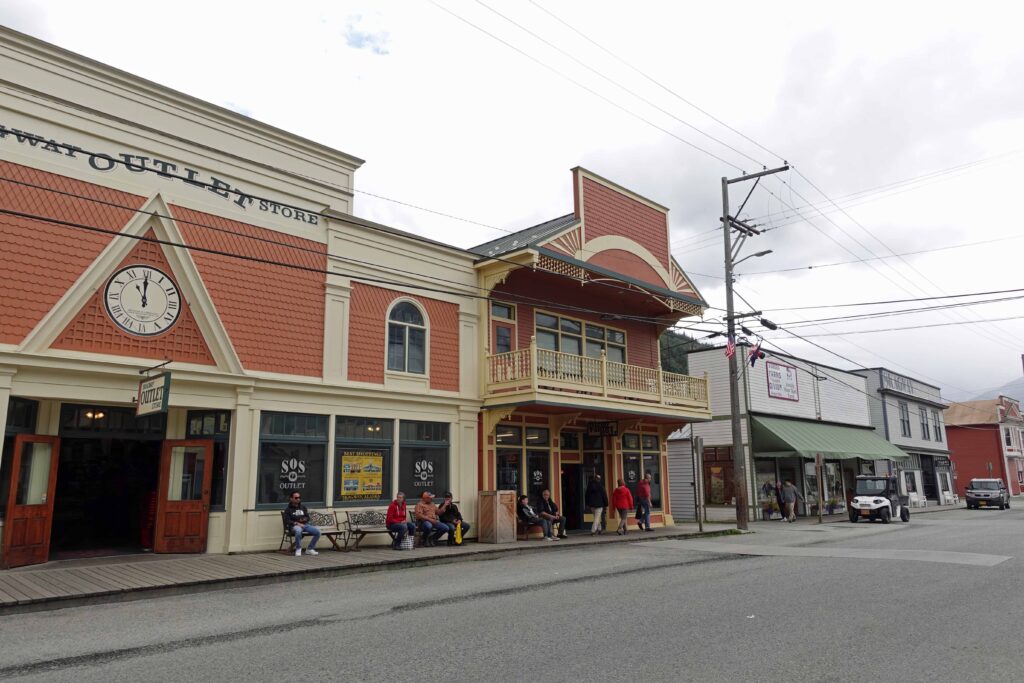
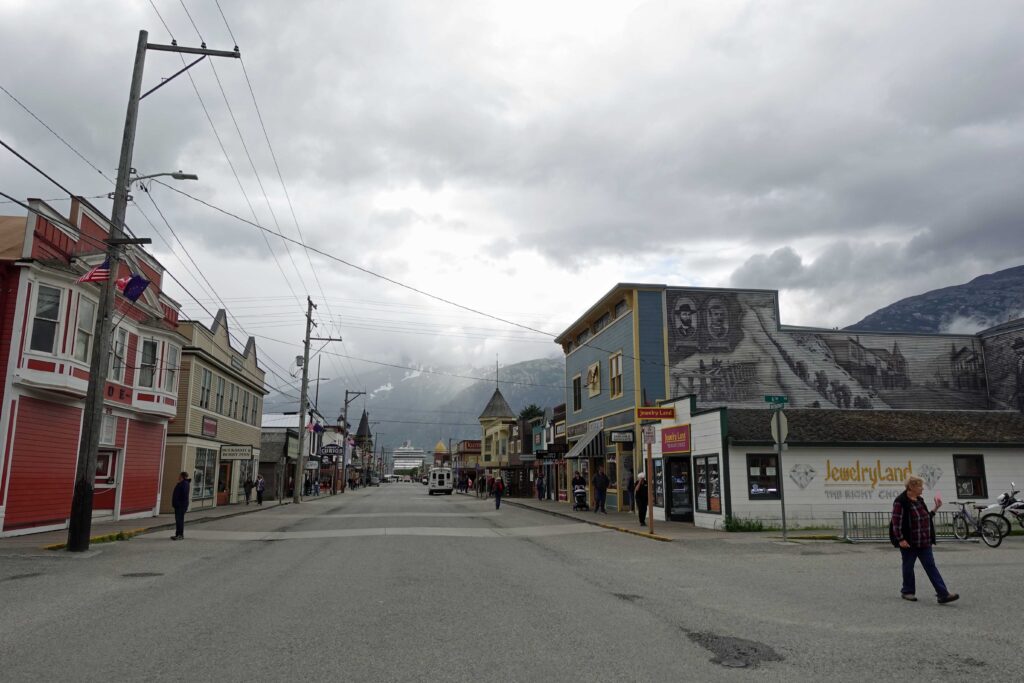
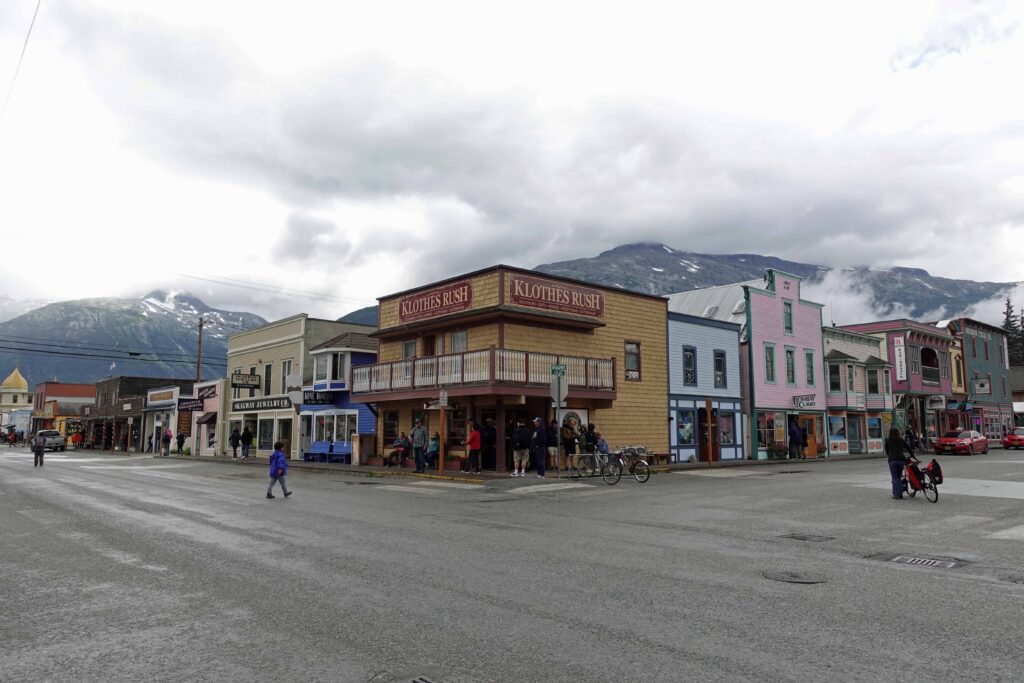


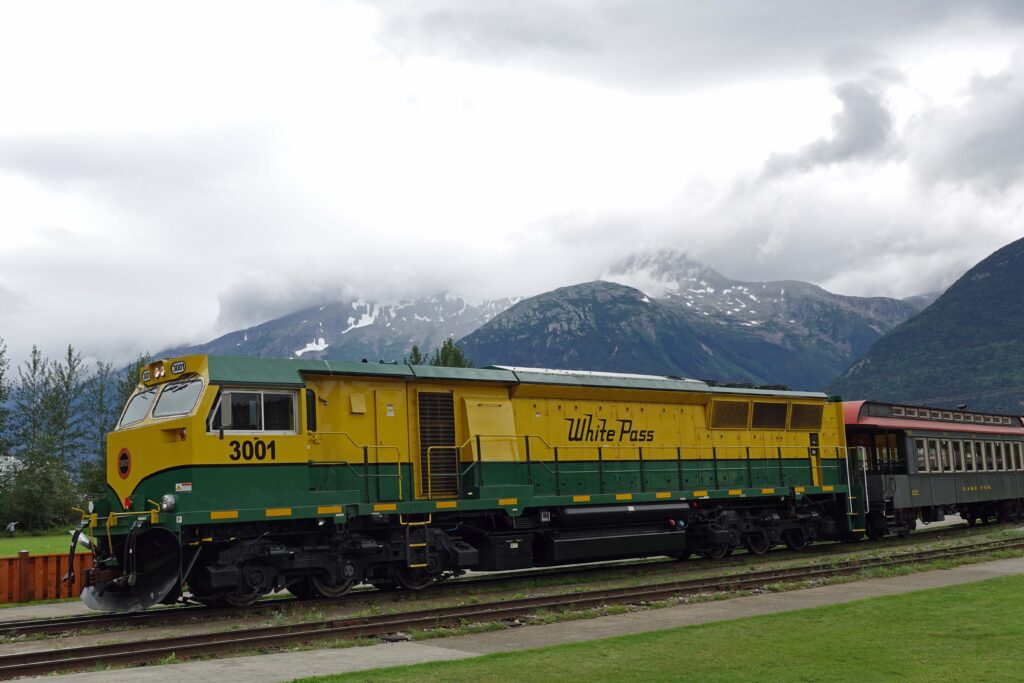
What is the longest running Broadway show?
In case you’re thinking: What’s the point of this question? – The main street of Skagway was called Broadway from the beginning when the first people came to the Klondike Gold Rush. Since 1923, a show has been performed there several times a day, “The Days of 98.” For a hundred years! I watched it.
It’s about a man named Soapy Smith, who made money in the Gold Rush era through many shady dealings and eventually died in a gunfight.

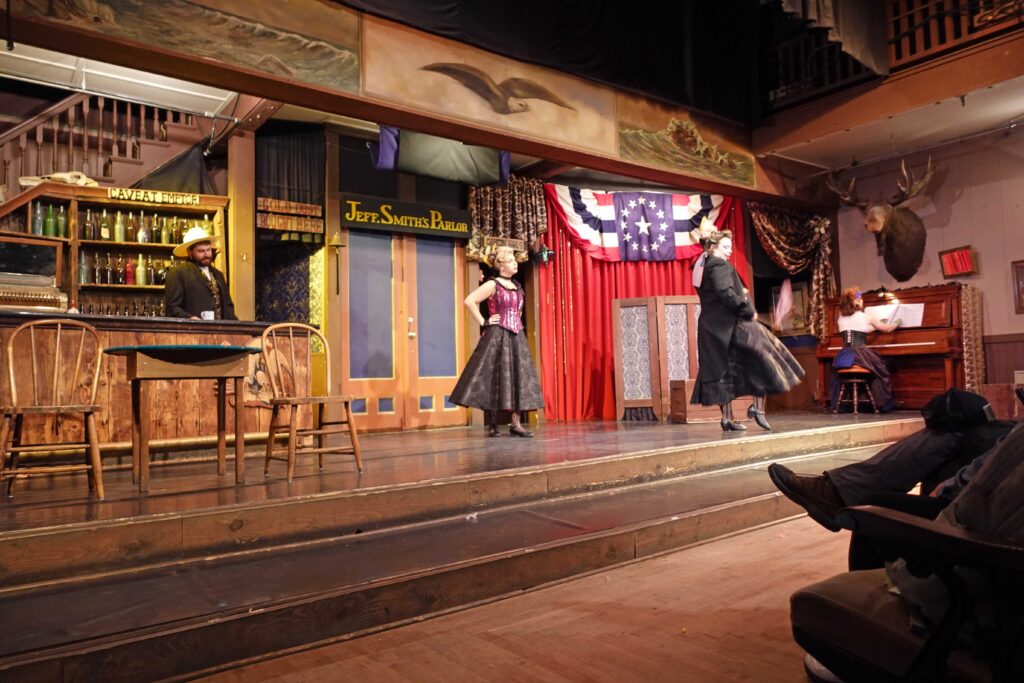
The pictures of the men (but there were also some women and children) who took the Chilkoot Trail are well known. 1,500 steps in snow and ice led up to Chilkoot Pass. Because the authorities wanted to prevent people from starving to death in Dawson City, they had to carry a year’s supply of food and other necessities. That is, they walked the route about thirty times. But the Golden Stairs were just the beginning on the way to Dawson.
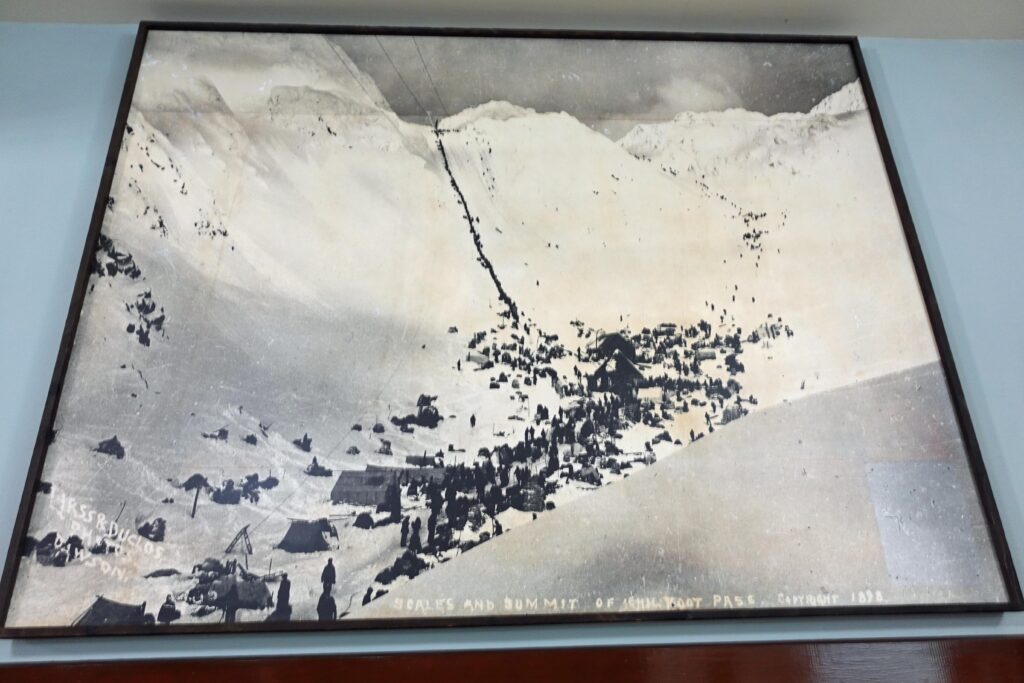
I really have to torment you with a bit of geology. Because if it’s been about gold all along, let’s now take a very brief look at how this gold got there in the first place, where Kate Carmack, or maybe George Carmack, found it while washing dishes in Rabbit Creek. If anyone wants to believe that George, who treated his wife so disgustingly, actually washed the dishes that fateful day. We don’t know. All we know is that Kate Carmack is not mentioned in Skagway either, but George very much is.
So, now to the geology: How does the gold get into the Klondike?
The earth’s crust flows on the earth’s mantle. Since the earth’s crust is solid, it has broken into fifteen large plates, which are now moving individually and in part against each other.
As mentioned earlier, southern Alaska is located where the Pacific Plate meets to the west and the North American Plate meets to the east. The Pacific Plate is thinner but denser, thus heavier, and pushes under the thicker North American plate, which is therefore compressed there.
This leads to three geological events: uplift, faults, and magma intrusion from below.
The collision of the plates causes uplift, creating mountains. The coastal mountains around Skagway, but also the Alaska Range with Denali are the result of these processes.
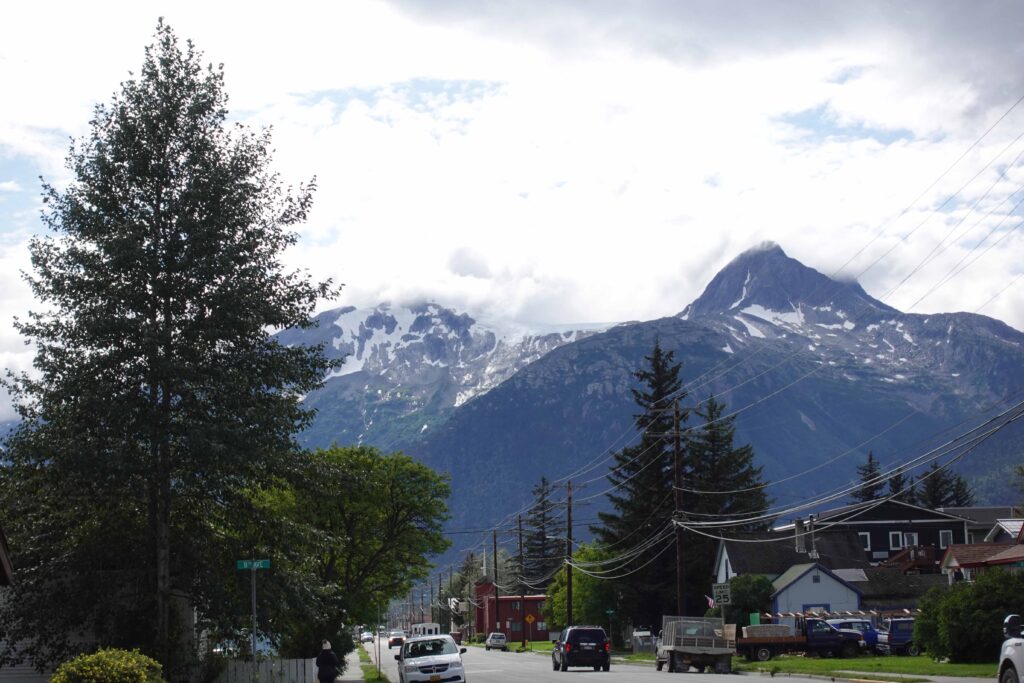
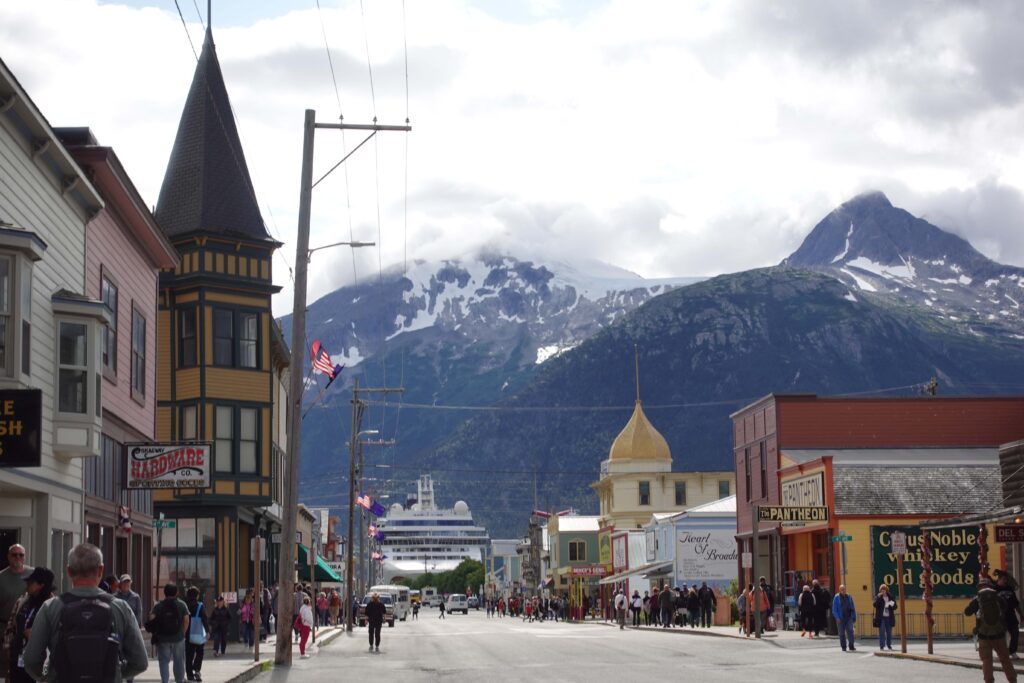
At the same time, the pressure also causes fractures in the North American Plate, which then become weak points. The Pacific Plate not only pushes northward, but also rotates counterclockwise, forming many faults and fissures. The energy of the movement is distributed among the numerous weak points, which means that there are often small earthquakes in the Skagway area, but a large one is not to be expected. For water, faults are the easiest way to make its way. Fractures and faults are often found under rivers, for example under the Skagway River and the Taiya River.
Fractures on the underside of a plate are usually filled with magma and enlarged. This also happens with the North American Plate. Trapped in the solid crust, the magma slowly cools to form giant granite bodies called plutons. Uplift and erosion turn them into mountains, like those north of Skagway.
The Klondike gold was formed in the following way: liquid magma seeks its way up through fractures. As it slowly cools and solidifies, super-hot water and other substances separate from the magma. The super-hot fluid is under high pressure and can fracture the surrounding solid rocks, creating cracks and fissures through which the fluid shoots upward. As it cools, solid substances settle out, including quartz, resulting in the formation of quartz veins. All the gold found so far in the Klondike solidified into quartz veins. Due to the uplift, the veins came to the surface after millions of years, were broken by erosion, and nuggets, gold flakes and gold dust ended up in the rivers. Since gold is heavier than rock, it gathered down in the riverbeds until that day when Mr. or Mrs. Carmack found it while washing dishes.
Once you discover gold in a river, go up until there is none left, and just below that stake your claim. Because that’s where the vein of gold is. It is still possible to stake claims in Canada and the USA today, provided they are not on private property. And even on the Klondike, it still pays to pan for gold. In Ontario as well, by the way, where the Lumberjacks used to work for the paper mills. There, hardly any logging is done anymore, but gold is searched for. And found.
I don’t need to do that anymore.
I washed Annie Way this time instead of Gold. She was in desperate need of it.
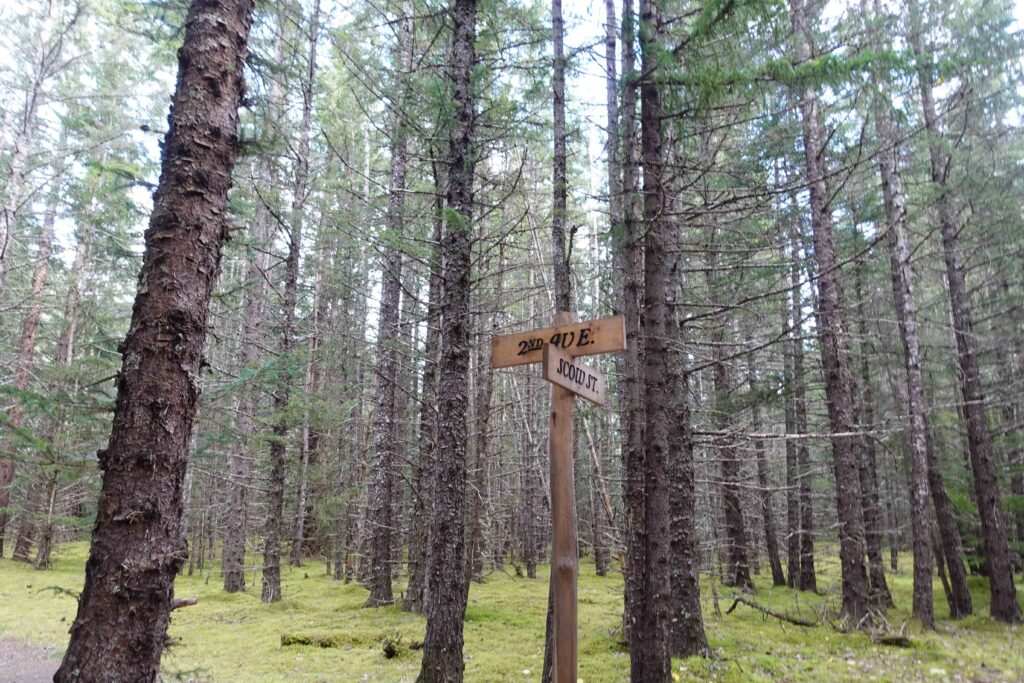
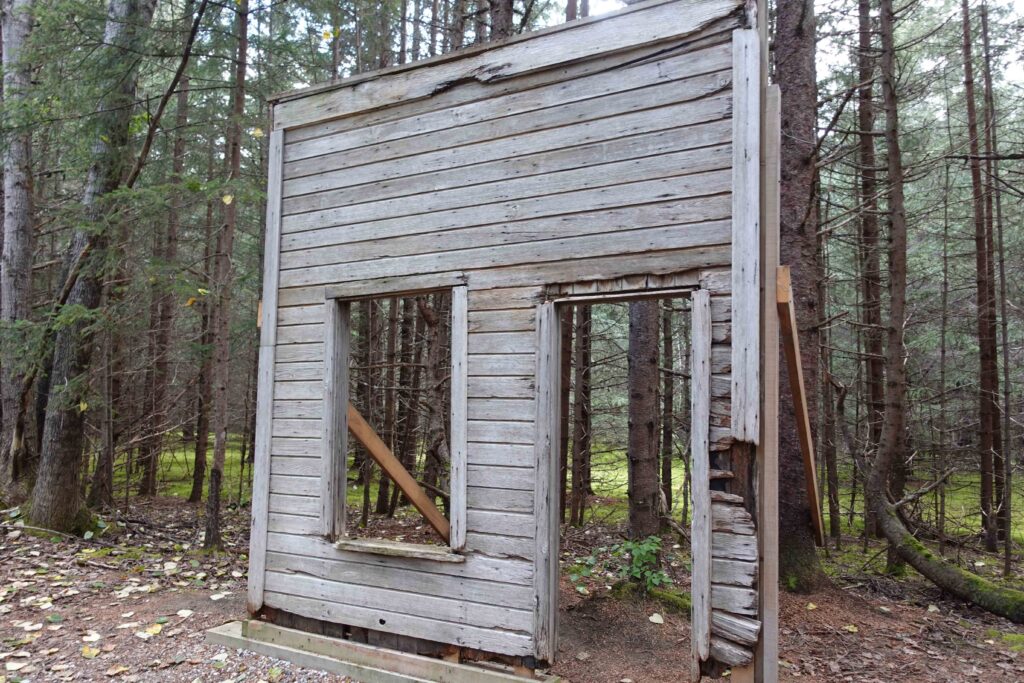
Before leaving Skagway, I visited Dyea, that former Gold Rush town from where the Chilkoot Trail started. There is nothing left of it, except for some boards of a boat, which lie far away from the sea in the middle of a forest. The land has risen about 1.5 meters since the Gold Rush, which brings us back to the starting point of the whole geological ordeal: the Earth’s crust flows on top of the mantle. Since the earth’s crust is solid, it is divided into fifteen large plates and so on and so forth.
